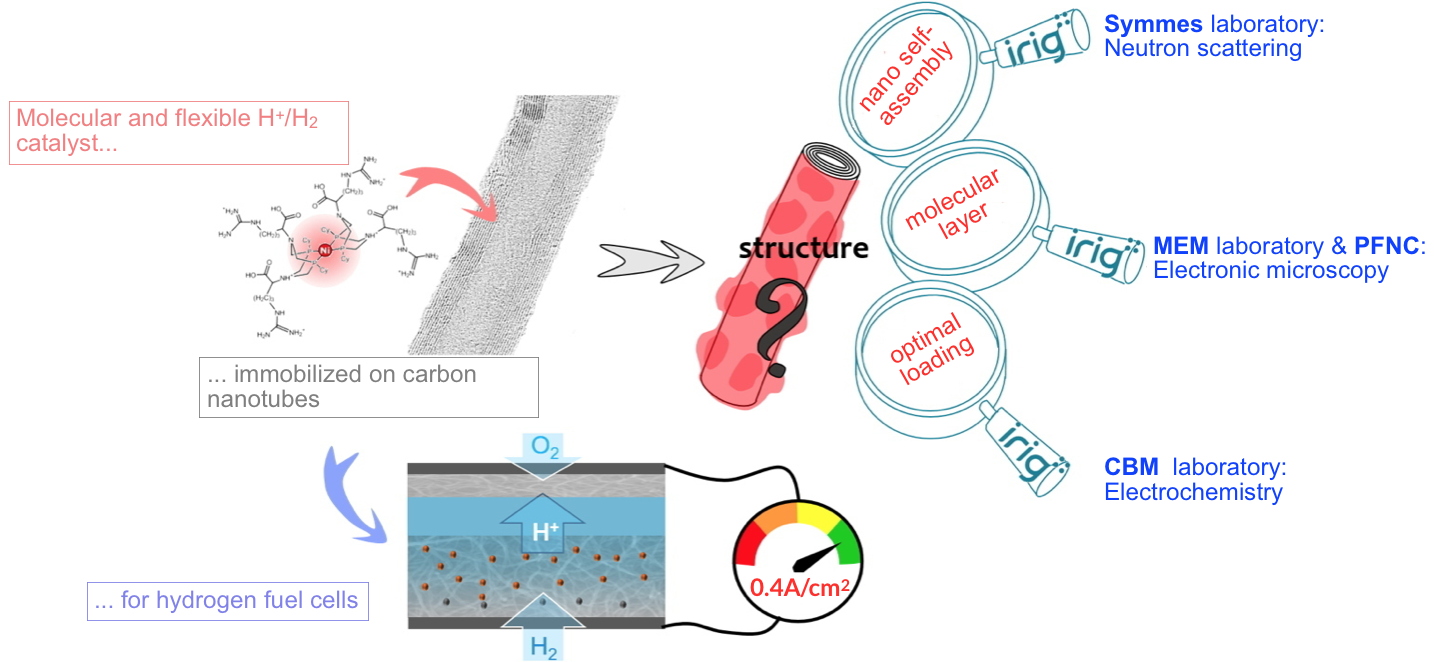The development of new energy technologies relies, among other things, on devices such as fuel cells that use catalysts to convert hydrogen into electricity. For this purpose, a family of nickel-based molecular catalysts offers a credible alternative to the use of noble metals in conventional hydrogen fuel cells. These molecular catalysts, inspired by the structure of the active sites of hydrogenases, outperform traditional catalysts both in terms of efficiency per metal atom and environmental impact. In order to efficiently collect the current produced during hydrogen oxidation, the catalyst must be anchored onto a conductive support. However, the way in which catalysts interact with their support is poorly understood.
Several research teams at our institute have developed different grafting strategies to maximize the performance of the final device. In particular, the conductive support should maintain a high porosity to allow access to the hydrogen gas, as well as a conduction network to transport the ions. Because of these requirements, carbon nanotubes are among the most suitable supports for immobilizing new catalysts
[1]. However, these catalysts, which are mostly organic in composition and have a mobile and flexible structure, cannot be modified without affecting their catalytic activity. Moreover, once integrated in the composite catalytic layer, they escape conventional detection or imaging techniques.
In
collaboration with two other laboratories at our institute and one CEA-Liten laboratory we have studied this elusive structure by combining advanced and highly complementary characterization techniques. All the results obtained converge towards a new image of the association of the molecular catalyst with its support: a homogeneous coverage of the whole available surface of the nanotube to which is added a regular and nanostructured distribution of small agglomerates of catalysts.
On the basis of these observations we have set up, in collaboration with the Joliot Institute, a fine control of the catalyst surface concentration. We were also able to optimize the hydration level of the active layer, a critical characteristic that ensures both the diffusion of gaseous substrates and ionic products. Thanks to these improvements, we have just achieved current densities of 0.4 A/cm
2 approaching the industry standard
[2] of 1 A/cm
2 achieved by conventional platinum-based electrodes.
The integration of this new electrode into compact hydrogen fuel cells will be the next challenge.

The
laboratories involved are:
• the
CBM laboratory at IRIG (
Vincent Artero,
Bertrand Reuillard) with a team from CEA-Joliot for sample preparation and electrochemical studies,
• the
Symmes laboratory at IRIG (
Pascale Chenevier,
Sandrine Lyonnard) for its expertise in surface characterization and small-angle neutron scattering, which allowed the observation of catalyst/nanotube self-assembly at the nanoscale in the presence of solvent,
• the nanocaracterization platform, the
MEM laboratory at IRIG (
Hanako Okuno) with the LCEA of Liten-DTNM (
Laure Guetaz) for the use of transmission electron microscopy to image the catalytic layer on individual carbon nanotubes.
This work is part of the PTC Materials and Processes BioPAC project entitled "Multi-scale physical characterization for optimization of bio-inspired PEMFC anode materials", and the FCH-JU CRESCENDO project (GN 779366) "Critical Raw material ElectrocatalystS replaCement ENabling Designed pOst-2020 PEMFC".